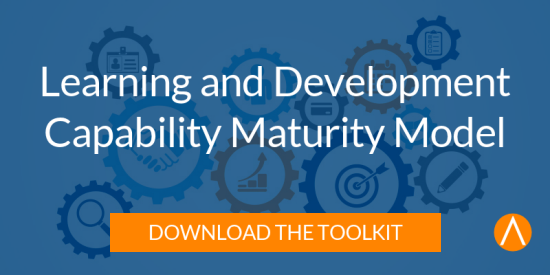Posted by Caveo Learning ● March 8, 2016
For Learning Leader Kim Hannan, Fun Leads to L&D Success
 This is part of our ongoing series, Interviews with Learning Leaders
This is part of our ongoing series, Interviews with Learning Leaders
Kim Hannan is manager of learning solutions for Equity Residential, an owner-operator of high-end apartment buildings. Based in Chicago, she started with Equity in 2003 as an assistant property manager before transitioning into L&D as a systems trainer. In 2014, her team was recognized with a Learning! 100 Award, as a top organization for innovation in gamification. She holds a degree in marketing from Middle Tennessee State University and is a member of the Kentuckiana Chapter of ATD.
Tell us about your approach to learning and development.
My passion is to explore learning, creativity, technology, and design solutions. I lead a tiny team that delivers big results, even without a big budget. We’re lovers of technology, and we create award-winning, innovative solutions that break the “old-school rules” and actually work. While there’s nothing traditional about the approach, even traditional corporate leaders see the positive impact on the company.
I’m soul-driven to create amazing learning resources, because the bad stuff crushes the spirit. I started as a team of one, and now I lead a “huge” group of three. My experience proves that it’s not impossible to do the impossible, even when it feels that way.
The key to our team’s success is sharing a common goal—changing behavior, not creating courses. We don’t take feedback personally, and we collaborate and evolve our designs to the point that we don’t know whose idea was what. In the end, it’s just something we create. We’re dedicated to our learners, even though business partners are our clients. We have to be their voices, so we approach everything with a “so what?” set of questions. If we can’t provide a good answer, it doesn’t go in our eLearning courses. And we’re ruthlessly committed to having fun while we change behavior.What is a career highlight for you, and why was it impactful?
The primary software we use to manage customer records is enhanced frequently. Many years ago, we would share release notes in document form and require all employees to review an online course with the enhancements each month. Finally, we dropped the course and relied on the document, since they were primarily the same content, but we still kept hearing that people didn’t read them, and many folks didn’t have the information they needed to perform their jobs.
After a particularly long week, I stayed late at the office and decided to write the release notes in a new tone. Instead of business and tech speak, I wrote something I would like to read—more conversational, funny, and including anecdotes from a fictional character who was the “expert” in the software. “She” even included fun shout-outs if an enhancement was an employee’s idea. People started emailing the fictional character asking when the next release was coming because they wanted to read the release notes. Corporate employees, who never even used the software, started reading them.
It was through this experience that I realized how powerful human connection and our voices are. People didn’t want to be talked at, but they wanted to be part of something and feel like they had a voice that was heard.
What are some specific training challenges in your industry?
Our field employees, who make up the majority of our learning audience, are our front line, so they’re always active and rarely available to just sit down to complete online learning requirements. They’re constantly needing to jump up to help customers, and about half of our learners don’t have their own desks or computers.
To overcome this, our business has implemented a team meeting time for one hour each week, and our leasing offices are closed so the whole team can come together to discuss important company topics and news. Once a month, that meeting is dedicated to completing online learning, so those who haven’t been able to complete requirements have dedicated time.
Furthermore, we have been designing shorter, more relevant courses that get to the point faster and allow learners to apply what they learn immediately. Most of our courses are less than 20 minutes now, and we use subsequent modules, online videos, or communications in wikis or on our online discussion forum to reinforce learning.
Do you have any advice about rolling out software to geographically dispersed teams?
Most software programs, especially SAAS and cloud-based solutions, change frequently, which means the learning solutions need to be updated. We’ve blended our curricula so that frequently updated resources are covered in quick videos that are easy to create, typically in an hour or less, and can be disposed of and re-recorded when needed. That’s much easier to manage instead of replacing every screen shot in an online module.
You’ve held some project management roles in the past; what advice do you have for learning leaders when it comes to PM?
It’s all about frequent communication, under-promising, and over-delivering. When creating your timeline, add at least 20%, and depending on the content owners, maybe even 50%.
I manage the timeline, but I lead my team and allow them to estimate how much time tasks will take. The creative process of instructional design is definitely an art. Yes, there’s a science to doing it well, but the art is what makes it impactful.
Topics: Interviews with Learning Leaders

